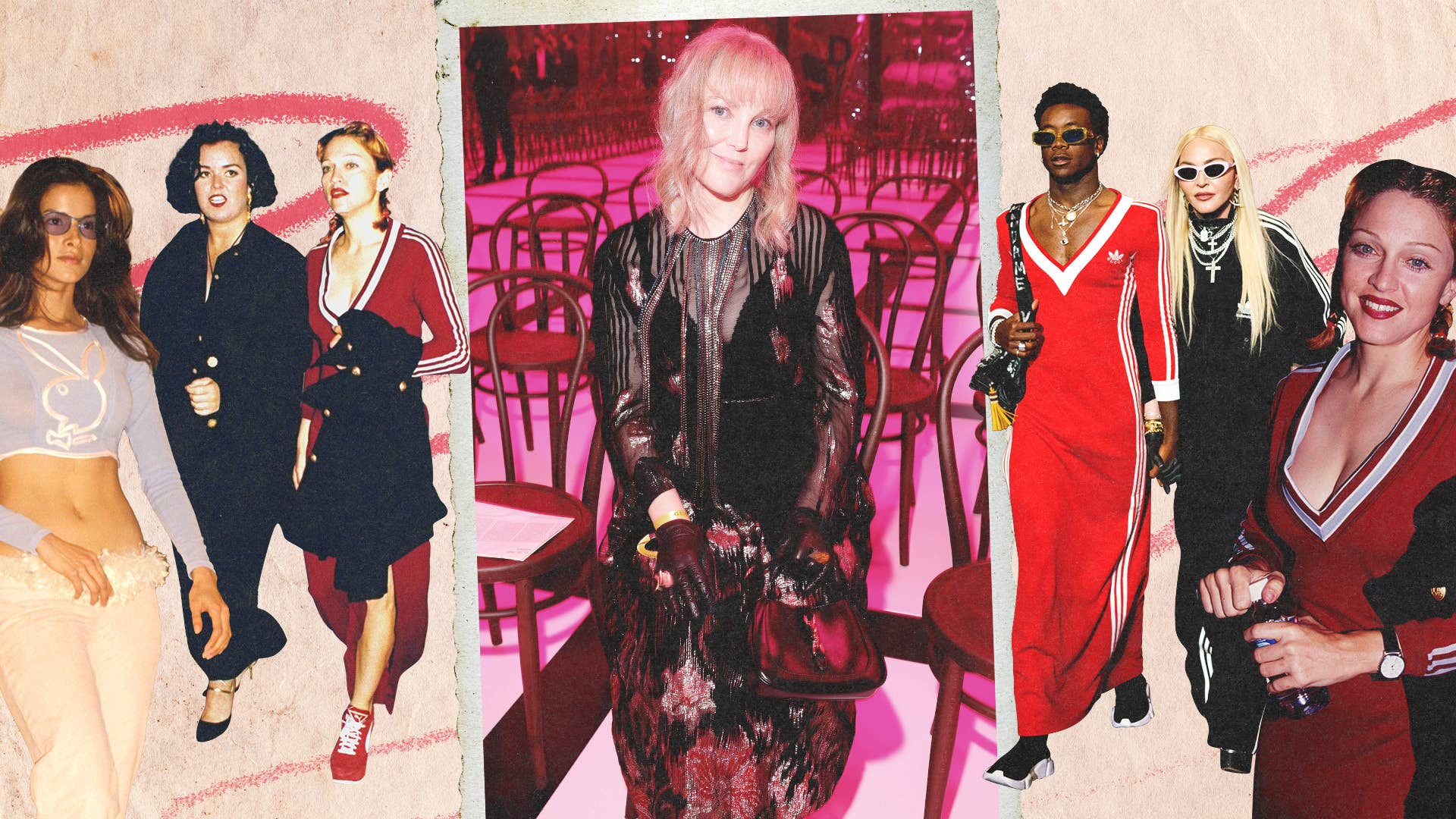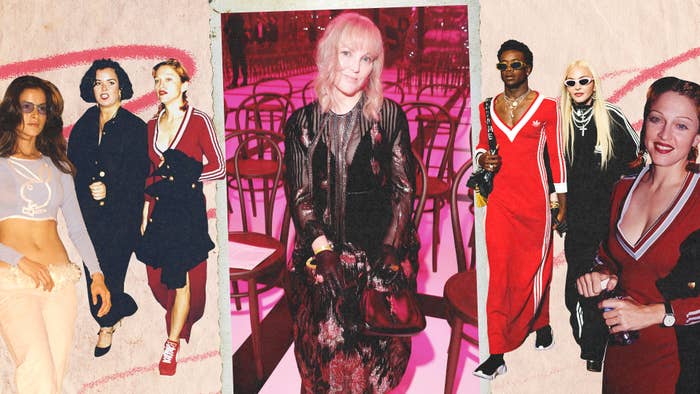
Laura Whitcomb was ahead of her time.
While it’s commonplace now to see streetwear brands subvert logos or turn sportswear into a more feminine iteration, Whitcomb was doing it in the ‘90s when no one else was, and partnering directly with brands for some of their first designer collaborations.
The Southern California native, who was never formally trained as a designer, started out looking to women in East Los Angeles who would wear cotton tank tops that featured their nicknames in Old English font. Whitcomb turned these tank tops, which are also referred to as wife beaters, into dresses for her friends to wear. But it wasn’t just about making a dress for Whitcomb. It was about flipping what was conventional or widely accepted, which could be harmful to others.
“My first collection was turning these wife beaters into dresses, and that name alone has this connotation of being polarizing to women. And I wanted to just create an extension of masculine ethos moving into something very female,” says Whitcomb. “I was active in the club culture of the time. And we saw the dance floor as a forum to promote new ideologies. And you were making this statement that kind of wanted to challenge cultural norms.”
She then moved on to sportswear, which is how she ended up designing a long red maxi dress with Adidas stripes on the side that was worn by Madonna. Years later, the singer’s son donned a version designed by Gucci’s former creative director Alessandro Michele that was part of the brand’s collaboration with Adidas. Michele reached out to Whitcomb before showing the dress and invited her to the show.
“I started really thinking about bringing sportswear into the conversation and what did sportswear represent and the language that you could convey and what new stories you could tell by just recontextualizing things,” says Whitcomb, who also operated a store, Label NYC downtown during streetwear’s very nascent days.
While Whitcomb has abandoned her store and the fashion industry—she currently curates art exhibitions—her legacy as a pioneer in the women’s streetwear space is important and not widely talked about.
We caught up with Whitcomb to speak about her time as a stylist during the ‘90s—she styled The Pharcyde in their legendary music video “Passing Me By“—what it was like being one of the first designers to collaborate with big brands like Adidas, Champion and Playboy, why she stopped designing clothes, and her current thoughts on streetwear.
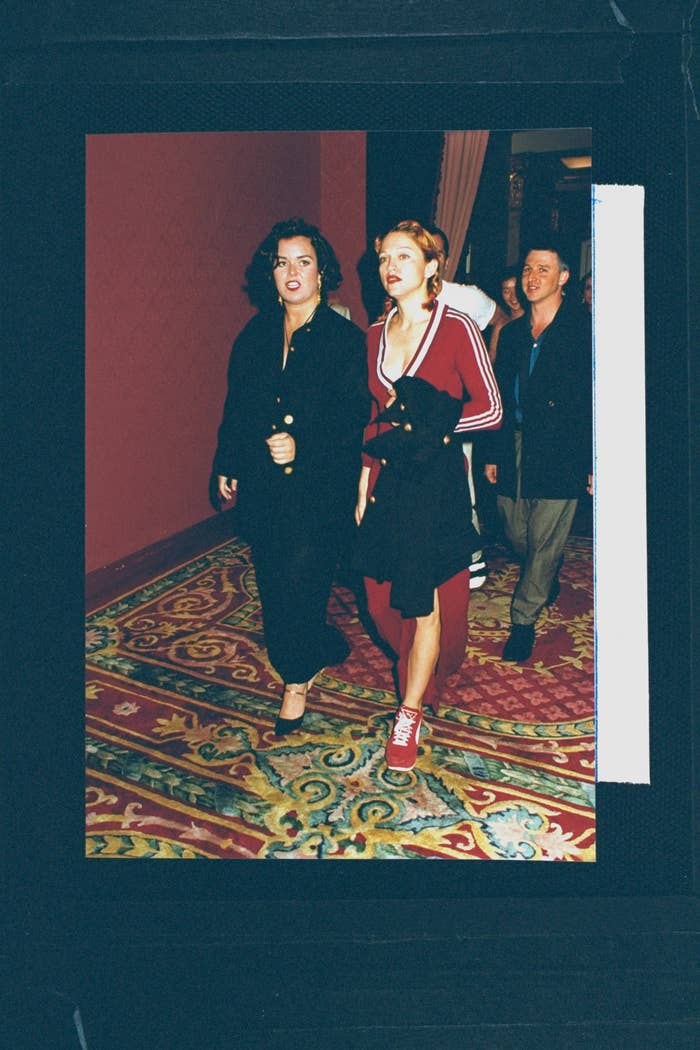
Let’s start from the beginning. You started Label in the ‘90s?
Yes. I didn’t start it as Label NYC. It was just Label. I don’t know if you’re familiar with movies like Repo Man or John Lydon’s PiL. There was always this generic food packaging that one would see. It came from a store called Ralphs in Southern California where I grew up. It really was important to us as far as iconography in the early ‘90s because it created this disambiguation between classes. Generic food packaging had its own iconographic language to itself. It would be a can of beer and it would have a baby blue and navy stripe at the bottom. If you were a kid in the ‘80s, because it was a very materialist time, the generic food packaging resonated with the post-punkers in California. And also it really made a strong statement to youth culture. So when I did Label, it was this idea that you would just have a simple label with the baby blue and navy stripe [like the beer can]. So it was a continuation of that conversation.
I went to school in Europe and I would come through New York when I would go home. So my upbringing was very transitory. But I moved to New York and it was really the place that embraced what I was doing. So I started a little clothing store on Lafayette Street. We were always Label but eventually it became Label NYC.
Can you talk about your first collection?
I grew up on the East side of Los Angeles and my first collection was a homage to the women of east Los Angeles. My mother taught at Fourth Street Elementary School. I grew up with a great reverence for the Latino culture of east Los Angeles and how women would have these T-shirts that had nicknames on them in Old English font. And they were always on wife beaters and it was a very masculine ethos. So, my first collection was turning these wife beaters into dresses, and that name alone has this connotation of being polarizing to women. And I wanted to just create an extension of masculine ethos moving into something very female.
It was definitely streetwear. It was made for my friends. I was active in the club culture of the time. And we saw the dance floor as a forum to promote new ideologies. And you were making this statement that kind of wanted to challenge cultural norms. And then I started progressing into working with different iconographies and telling different stories. That’s when I started really thinking about bringing sportswear into the conversation and what did sportswear represent and the language that you could convey and what new stories you could tell by just recontextualizing things.
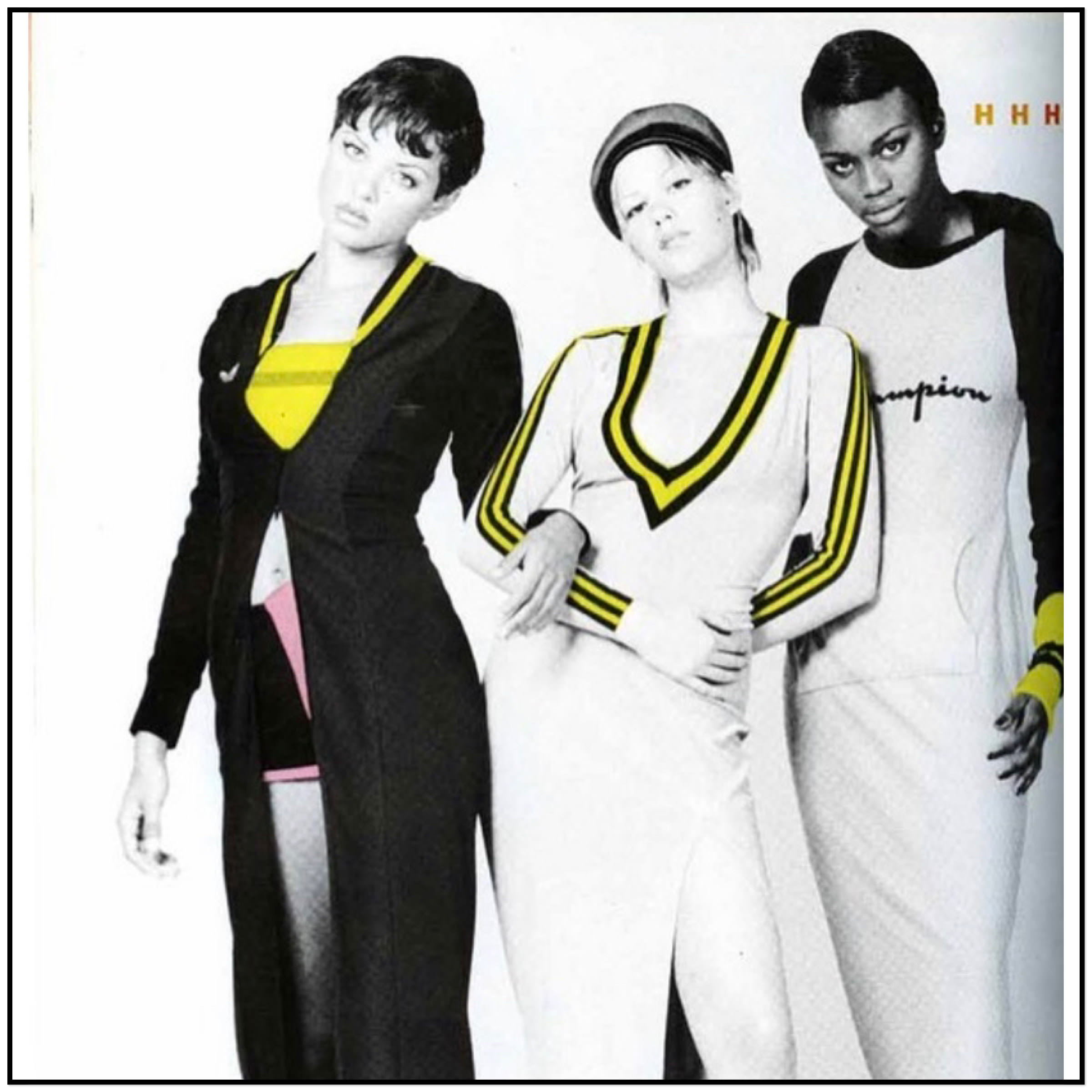
What was happening in New York with streetwear around that time? Did you have any peers?
Camella Ehlke of Triple Five Soul was very active. I was a stylist before I was a designer. So I borrowed from Triple Five Soul. I pulled from FUCT. I pulled from Stüssy. I was working with all of the streetwear brands because I would often do photo shoots. I had a great respect for Camella who was well ahead of me with Triple Five Soul and she was collaborating with Giant Step, which was an amazing club. There was this whole culture that was brewing in New York. And I think that was what really attracted me to New York. It had this sort of culture that was really merging with clothing more than Los Angeles because Los Angeles is so spread out. I think it was exciting to see a young woman doing what she was doing.
Who were you styling by the way?
I did the Pharcyde’s first video “Passing Me By.” Sanji directed that.
Oh my God. That video is iconic.
Yeah that was really wonderful. That’s where I first showed the Adidas dress, in that video. I didn’t style all the women. I did Fatlip and all those guys and they were wonderful. They were just so much fun. But then I was doing a lot of other things. I worked with Tina Turner. I did the Red Hot Chili Peppers video. I mean, it was kind of all over the place because at the time I was young and there weren’t any stylists in Los Angeles. Everything was shot in New York. And I was one of the few stylists in the late ‘80s early ‘90s. I worked with Cypress Hill. I worked with Boo-Yaa T.R.I.B.E. I worked with Yo-Yo.
So the director’s name was Sanji and basically he hung the guys to these line bolts from their feet and I had to pin everything so it didn’t look like it was falling down. I had to be very careful not to poke anyone. There was just a lot of magic on that set and one best videos I ever worked on. And then I worked with the Pharcyde afterwards and funny enough, there was a man at Adidas named Ollie and he was the man that made the whole Adidas thing kind of happen. So he would give me Adidas product to put on all the artists that I was working with. There was a show that the Pharcyde did and Tupac performed, and The Beatnuts. It was this great show and I styled them for it and it was a lot of fun. These things are coming back in flashes.
You were based in LA when you were styling?
Correct. I was here. I worked with Proper Grounds. He got sort of swept under the rug of history, but he was doing hip-hop and metal and that was Guy Oseary’s first managed artist and I think that’s what led me to Madonna, because Guy was working with Madonna.
I’m looking at the video now. Wow. I see the dress.
I pinned all their clothes, so they looked like they were upside down hanging or right side down. Those were some really wonderful years.
Then you moved to New York and you opened up a store called Label NYC, right?
I might have to go back a little bit. So this would’ve been around ‘93. The photographer, Cheryl Dunn, brought me out to New York to do a photo shoot. And that was the photo shoot with Spin. I worked with Guru who was another absolutely phenomenally, incredible human being. God rest his soul. Luscious Jackson, an all woman group that include the former drummer of Beastie Boys early hardcore punk band Kate Schellenbach, along with Proper Grounds, YoYo and Heather B. So we did a story for Spin and then I ended up staying in New York because of Tommy Boy Records and I developed a relationship with Tommy Boy.
Tommy Boy sponsored my first show. I did this Carhartt dress for Tommy Boy. I don’t think anybody’s ever seen it. It was a Carhartt jacket, but I wanted to make it a female thing. So we made this Carhartt dress and that was the invite. Because Tommy Boy had these big embroidered logos on the back of their jackets. So we did that on a Carhartt dress. And that was the invite for the show for the show opening.
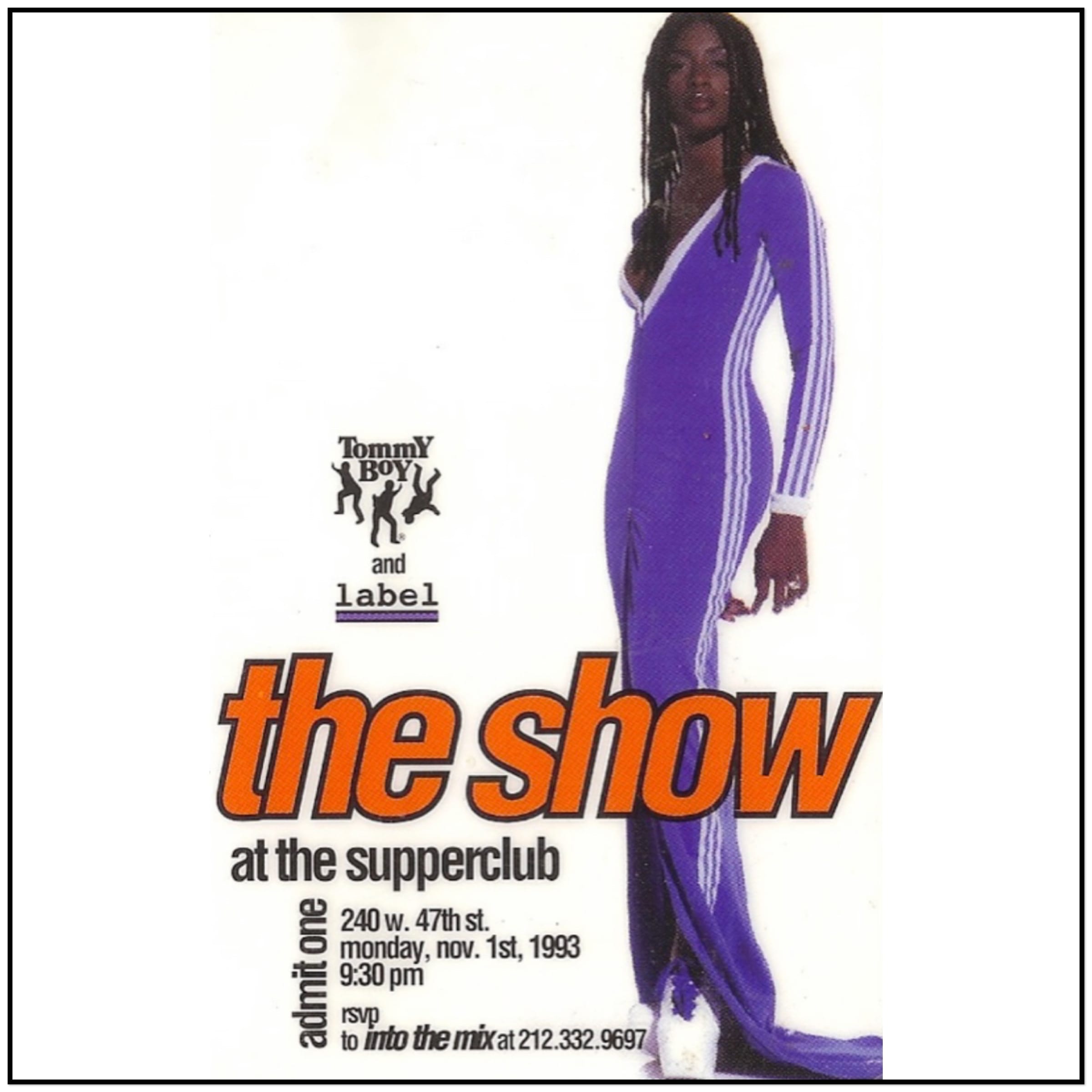
So it seems like you were all about recontextualizing iconography. But what made you say in general, I want to turn this into a dress?
I first came up with the idea. I was in Paris. I was at a warehouse party and there was a group of young men. If I remember correctly, they were from Senegal and they were dressed in these Adidas tracksuits and they had tucked a cravat, it almost looked like Hermes cravats, into the top of the zipper in the same way the French do their cravats. He had this perfectly proportioned beret and it was a group of young men and I began talking to them and I realized there was this element that needed to be there where it was just a female that was embracing this. I’m gonna call it a disambiguation because that’s how I saw it. A disambiguation of the parameters of what sports were represented and what dissolving boundaries around what was then high end couture and fashion represented. Because that’s what they were doing. I mean, they were actually just dissolving two worlds and reinventing something so powerful to me and I just conceived, you know, how light descends and you just have this idea, and I just thought that that would be this perfect unison of what they were doing. And then I came back to LA and I had the opportunity, I made them.
Was X-Girl happening at this time?
We started at the very same time. There was a store called Funkeesentials, which is a really important store in Los Angeles. It’s never really had its due. It was run by a lady named Sally and the other lady’s name was Pauline Takahashi. She really is a major streetwear pioneer that’s never really gotten her due. She started doing the low-cut jeans, but also she sold some of the best brands that were available at the time. And they really created that very specific Los Angeles genre. And then in New York you had X-Girl starting and Triple 5. XLarge was supporting X-Girl, but X-Girl was really important as well. That was Kim Gordon doing the line with Daisy von Furth. And I believe Sofia Coppola was doing a T-shirt line if I remember correctly. And she was close to the X-Girl community.
So you do this Tommy Boy show that’s re-envisioning Carhartt pieces as dresses, right. When did you present the Adidas dress?
I showed the Adidas dress. They had been seen before, but like a little birdie told us that a lot of Seventh Avenue houses were copying the collection and Tommy Boy wanted to sponsor a show so that I could have a voice and be represented. I made the Carhart piece only for Tommy Boy’s marketing. But we showed the Adidas dresses. I also introduced the uniforms because we were doing New York Metro dresses and UPS dresses.
So many brands do this now. But were you working with Adidas directly?
No, no. What I did was I made them on my own. I didn’t go to fashion school, but I had the luck of living with many fashion designers when I lived in London. I went to school in London from the age of like 14 to 19. I lived with a lot of designers who went to Saint Martins or London College of Fashion. So I kind of learned, but didn’t learn well enough that I knew what it took to make a garment. I sourced the fabrics. I had a place that wove and the trims. I had custom, two-way zippers made.
In the beginning it was only my friends wearing the dresses. But I was working with Guy Oseary and he was like, “Can I show Madonna one?” And she wore them to the Knicks games and I was very concerned at the time. I thought I’d be in a lot of trouble because I did receive permission to make just a few pieces from these sportswear companies because they were for a magazine editorial. And Madonna just wore it to the Knicks game. And so I called Adidas and they were so excited. They said, we will give you anything you want, whatever you want to do, you can do, which is, you know, something said in excitement. And then we formalized a contract in New York. Somebody had organized a pro bono lawyer to help a young woman starting a business and that was done through Skadden, Arps. They finalized a contract with Adidas, but I was young, we also had the LA earthquake, which destroyed my production. So that’s why there was a lot of opportunity to knock it off. And it was an exciting time but there were definitely some real obstacles that were setbacks.
So what was the deal with Adidas?
It was meant to be like a licensee. It was the first license and I had permission from Champion, Everlast because I did boxing gowns that looked like their boxing shorts. I also did shoes. They were made pretty much by hand but they held up, Madonna ordered some. I was working with her assistant Missy and she ordered more and she wore different dresses four times. And then Missy had said that she wanted me to do some designs for the The Girlie Show World Tour, but it was a little bit difficult because the LA earthquake happened. I had all these orders and I was just young. I did sketches, but I didn’t finish everything in time. It was definitely a really interesting process to see how that parlayed into the public receiving it. I didn’t necessarily expect that.
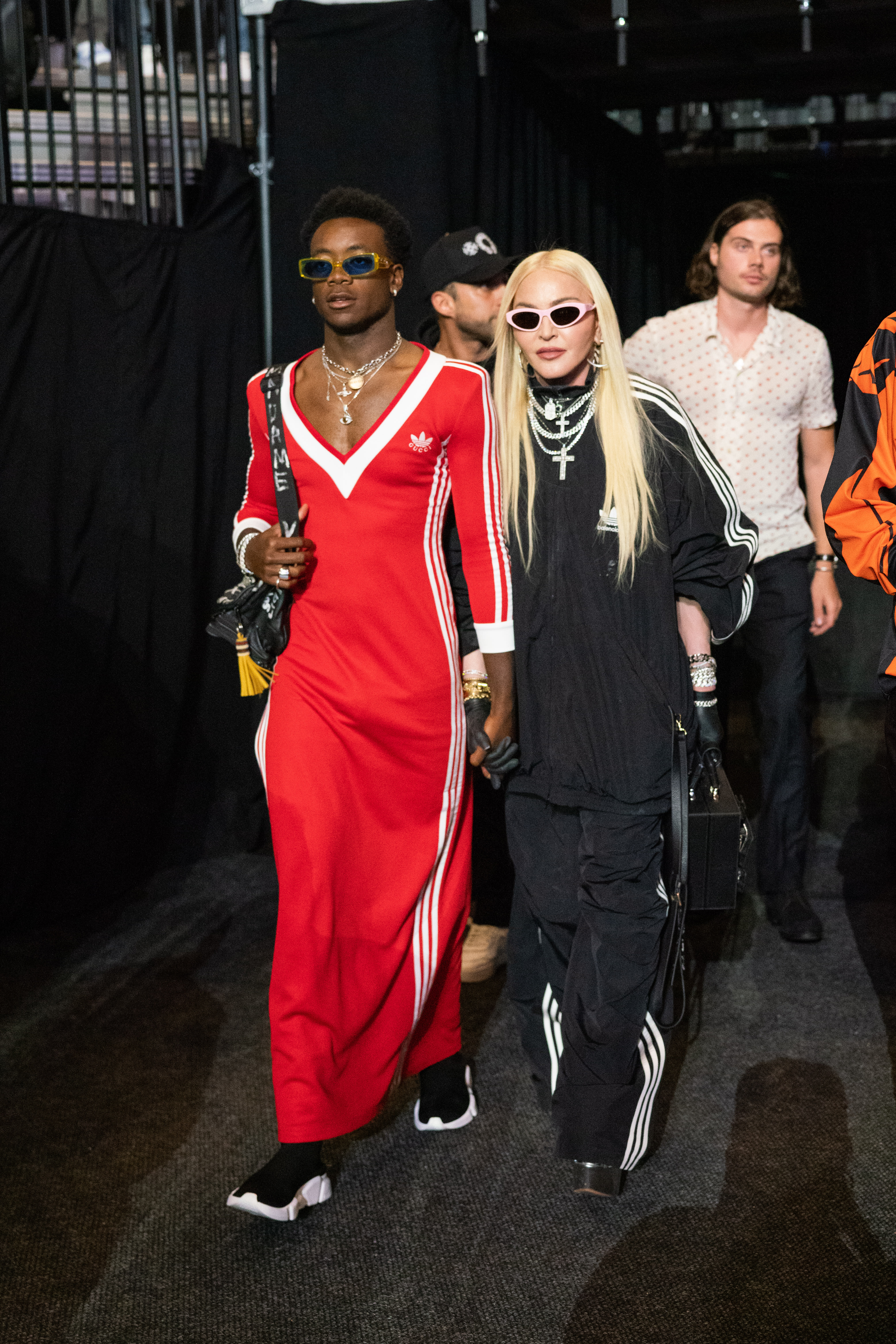
Did you sell any of the dresses in stores?
I sold them to Union. James Jebbia used to carry them. I sold them to X-Large. Only streetwear stores. I sold them to Funkessentials and they would just sell out. Macy’s funny enough approached me because they said that they would finance doing windows and have Futura and Lee Quinones work on them. I loved the idea of a department store generating money for artists to do [something]. And everybody was a little disappointed. They just thought like, you know, why aren’t you doing Barneys or why are you selling out? But I thought it was important at the time to see my community see a generous income come in.
It was the early ‘90s and it was still the recession. I just continued selling them, but because they had been knocked off so extensively, there was a shipment that one of the knockoff companies had done that was going to Britain and British customs intervened. And I think at first Adidas thought it was me and it wasn’t, so it just got to the point that I couldn’t control things because it was getting to the point where I was getting knocked off internationally and I just didn’t have the infrastructure.
I’m assuming it was just like random apparel brands that were knocking it off. Was it anybody with a very familiar name doing it?
Yeah, but I just don’t wanna disparage anyone. But it was a lot. I even had instances where people tried to pay off my factories and things like that. We didn’t have Diet Prada.
So you had a lot of celebs wearing your pieces. Tyra Banks. Yo-Yo. Madonna. How were you doing financially at that moment?
That wasn’t what was important to me. I think really it was this momentum that you were shifting new ideologies. You were creating a forum through the platform of clothing to encourage a new consciousness because the whole idea was to decentralize the hierarchy, you know? I mean, capitalism worked so well and marketing had worked so well because it tapped into this kind of atavistic psyche that we have where we look towards symbols to give us a mystical meaning and our brains are wired for the power of icons and symbols and brand marketing really knew this. And I think originally what the youth culture of the time and the community of clothing that I was working with were trying to do is they were trying to create this disambiguation and make people really consider like, are we sheep?
We need to independently think for ourselves. By having a new conversation with these powerful symbols, it was so exciting because there was so much potential from that because it was empowering all these young people to start their own companies. And that was the most important thing to me is that, you know, as a young woman, I was telling other young women that you can just do something DIY with no money and just hustle the best you can. And it can happen if you work really hard. And I think that was the most important thing to me because it was still the early ‘90s. Like the corporatocracy had not taken over, there was this hopeful momentum happening. And, I think those were the most important things, because, I mean, certainly a lot of those brands could have taken it to the level of Supreme. But I think the most important thing was our integrity, that was worth more than any dollar amount could ever be. Because it was a spiritual cause.
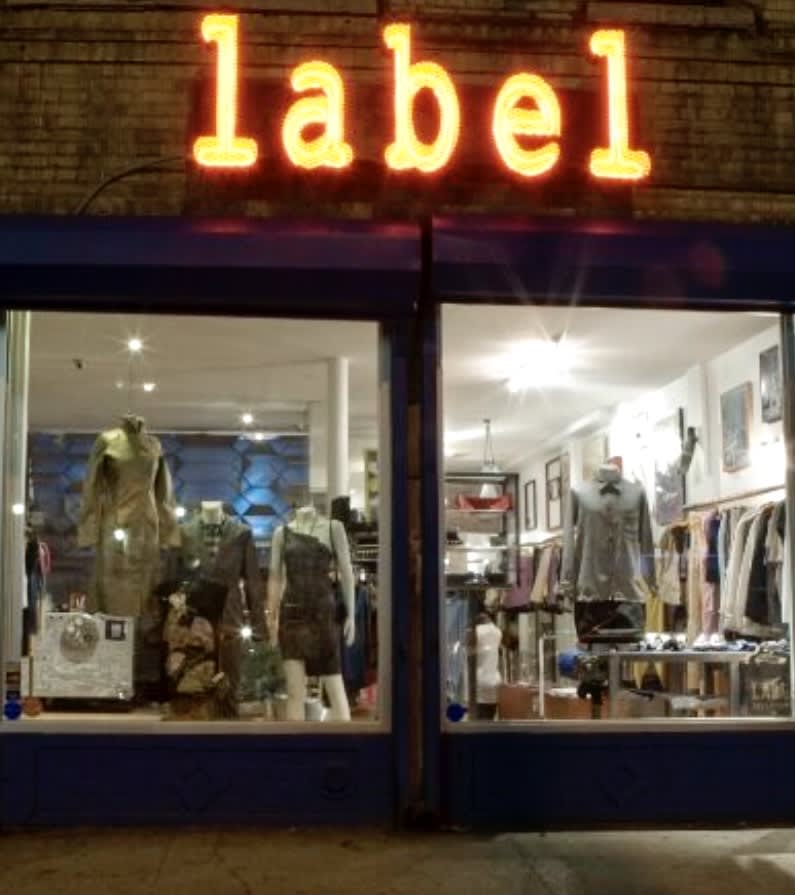
Well, when you say it was a spiritual cause what do you mean by that?
We were supporting a community that really circulated around the culture that was coming out of hip-hop. For example, growing up in Los Angeles, many times when I had friends of color in my car I would be pulled over by the police. Growing up with these and other normalized oppressive limitations was just so utterly egregious and disgusting that it made me feel ashamed to be human.
So the dresses are doing well, you have your store. What happened with the Adidas relationship?
I was represented by a showroom that had at the time Alexander McQueen and Lola Faturoti, who’s a wonderful designer. They pressured me to do something new and I wanted to really address feminism on a new plateau by appropriating a symbol that I believe stigmatized women. I thought it would be really interesting to appropriate the Playboy icon. So when I did that I was a young woman not understanding how business works. I wasn’t involved in that contract. I was given a license by Playboy to do whatever I wanted. They sponsored a show at Bryant Park and had just incredible models. Everything was organized by the publicist and I wasn’t really in charge of the more intricate details of running it.
After that I wanted to then explore other ideas of elitism and culture. And I took on the James Bond theme. And we actually, again, got a license through that. At one point I realized that a lot of brands were starting to explore these ideas of appropriation, but what was happening, it was almost like now we were empowering these corporations we were trying to sort of put into question.
Why do you say that?
What I mean is if I was gonna create a business model of working with brands for the duration of my career, I just started really exploring what inevitably I was doing. I wanted to decentralize the hierarchy. I wanted young businesses and other young people to be inspired to create their own symbols, their own logos, their own brands. We were encouraging this engagement with renowned logos to really question their hold on us. So the idea was to elicit and encourage younger people to just kind of create their own movements. I didn’t want to follow this business model anymore. I wanted to go back through history and think of people that really inspired me. I did a Che Guevara collection. We really explored a lot of movements that challenged authority and sought more inclusion and higher ideologies. And that’s when I just completely pulled back. I didn’t wanna be a big brand. I just wanted to be a little store on Lafayette Street that had community, and we started doing art shows in dialogue with the themes of the collection and I was just happy with that. Ultimately I’m a storyteller and it let me just tell the stories without anyone telling me how to tell them.
Did that eventually lead you to not making clothes?
I closed the store in 2010. I made a few things just for myself in the years after. I studied fashion history at UCLA in 1989 and that was a seismic shift for the youth culture psyche. did a paper on Dali’s work in fashion exploring a lot of his hermetic ideas explored through costume which I found really interesting. Coming out of London where I knew many provocateur-designers challenging the hold symbols held over us, I became particularly drawn to the power of paradox and the uncanny in clothing. I came to understand that a porthole opens to question larger issues when familiar worlds are shockingly reinvented. In 2010 I returned to my research on surrealist explorations in costume and presented it to the Dali Museum in Figueres and began working there before returning to start a curatorial company focussing on the influence of Surrealist objectives upon American culture.
So how did you feel when you saw the Gucci dress?
Well, they called me before. I was deep in a pile of work and I had known that it wasn’t a prank call because they had gone through a gallery I’d worked with. I’m just a very spontaneous person. If somebody invites me to go to Milan in two days, I’ll go. It was really interesting. It was very emotional.
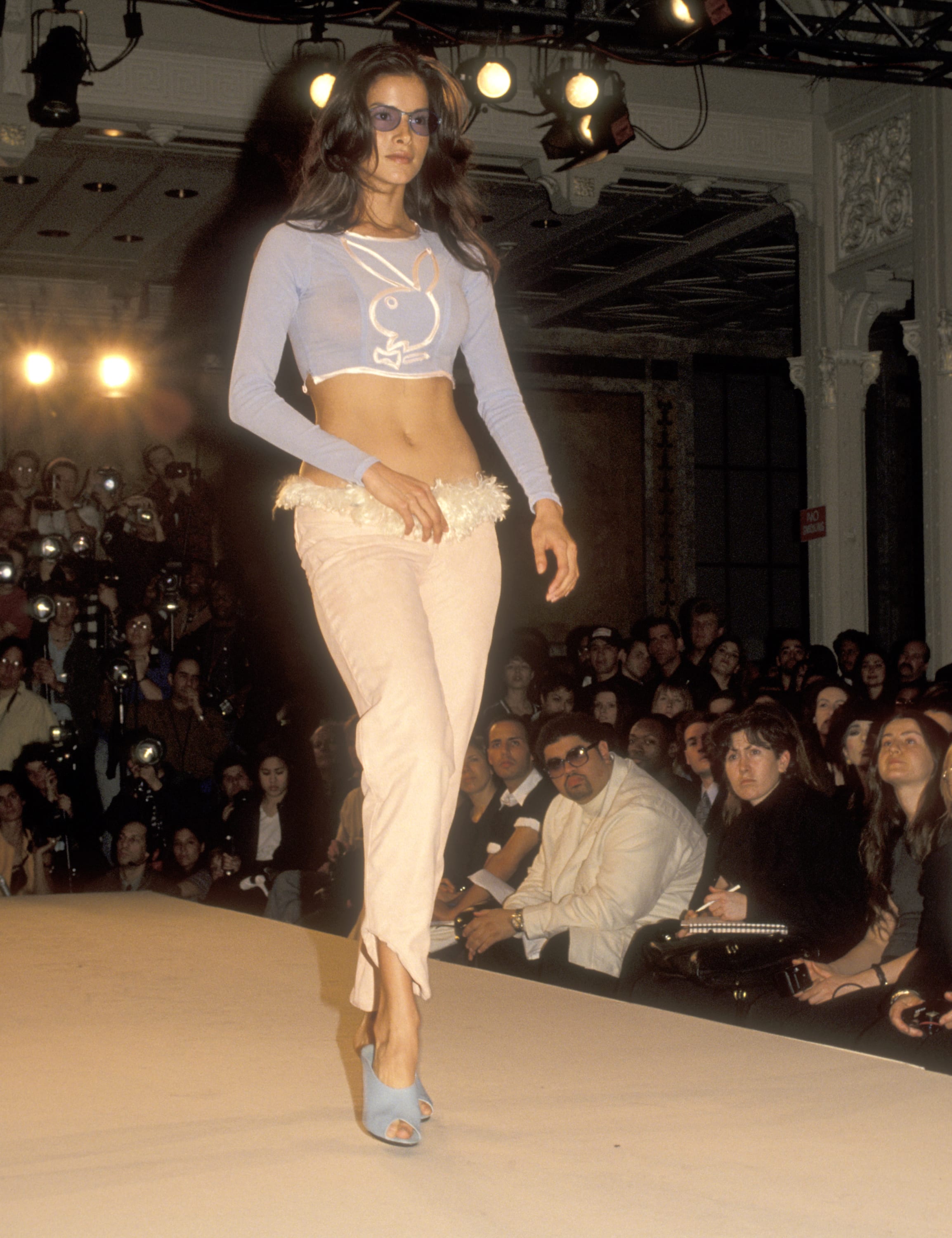
Why?
I had never had an atelier or just had the capacity to execute my designs to that level of quality and so there was that part of me that was the artist that I had thought, “Oh, if only I could have had that fabric.” I thought it was so generous of him to not do what other designers have done where they’ve just copied it and never credited whatsoever. I thought it was very generous of them to do that. I really like the fact that he has a very deep, intelligent underpinning to his approach, to his collections and to me, I see him as an artist working from that vantage point. So, I definitely have a great respect for what he did.
How do you feel about how streetwear has progressed? When you were describing those gentlemen from Senegal earlier, where it was just kind of this like mix of their type of luxury with their identity, with this Adidas tracksuit. It’s always happened, but now it’s on the Gucci runway. So I’m curious to know how you feel about its evolution.
I almost wonder if unconsciously there’s an element of accelerationism to it because what’s happening with all these brands just becoming just this closer and closer denser network, I wonder if it might all implode on itself. Is that gonna leave less of a voice for the radical individual just to be able to assert on their own. I think the whole collaboration thing has been interesting, but I think people need to go back to the early ‘90s and really consider what the original impetus of that was. Because I feel these collaborations are kind of almost deconstructing what our intentions were.

And your intentions were to circumvent certain hierarchies?
Yes. To decentralize the hierarchies, to create a more democratized environment for creativity. The whole DIY movement kind of started when that wall came down in 1989 and it was it. We grew up thinking there would be no future. And then suddenly the wall comes down. Not to discredit things being serious now, but when that happened, that was just an unimaginable miracle and the way youth culture responded to it, that’s when the wave culture completely became momentous. It was part of this celebration. Through creating this other industry through club culture, that is how the clothes emerged. We didn’t have the internet. We didn’t have these amazing ways to communicate and find out and research. We basically just had to stick to this one rule-shifting consciousness. I think, what these brands that are sponsoring young designers and doing things with new artists and generating income to support those communities. I think that’s great. I think these brands that are sponsoring young designers and doing things with new artists and generating income to support those communities is great. But I think the most important thing is to not have this religious veneration for a brand without question. That’s the danger.
I see Harold Hunter was in one of your campaigns.Can you talk a little bit about that?
Yes, I’d be happy to. It’s hard because I get a little emotional sometimes, but Harold was a very, very good friend of mine. I had known him before he was shooting the film. I lived in the East Village. He was this just hysterical young man that just made everyone laugh. When I started the store, I was really having a hard time. The store was infested with rats. Somebody kept gluing our locks every night and Harold just became my best friend at that time. He became our security guard. He and Justin helped build this little room in the back for me to live in. There was a community of these guys, it was that early Lafayette Street community. Harold is someone I deeply loved and will always love. The kind of person you only meet once in a lifetime.
He really changed a lot of us. He really was there for me in one of the hardest times of my life. He’s very, very meaningful to me. Those photos we had given to someone for his foundation to do T-shirts to go back to him. I always would make any of those images available to anyone who wants to use them for brands for as long as it goes back to his foundation.
Harold was an absurdist. Harold was a regulator of the scene’s psyche giving us no choice in taking the material world too seriously. He deconstructed everyone in a matter of minutes—popping egos, deflating us from survivalist mentalities—illuminating the ridiculous as the greatest state of gnosis. When Harold left this plane, so did that reminder. Ultimately we are here to build utopias and the only way to do that is question all of the illusions and rest on one solid thing: love. I hope one day he becomes a Saint.

